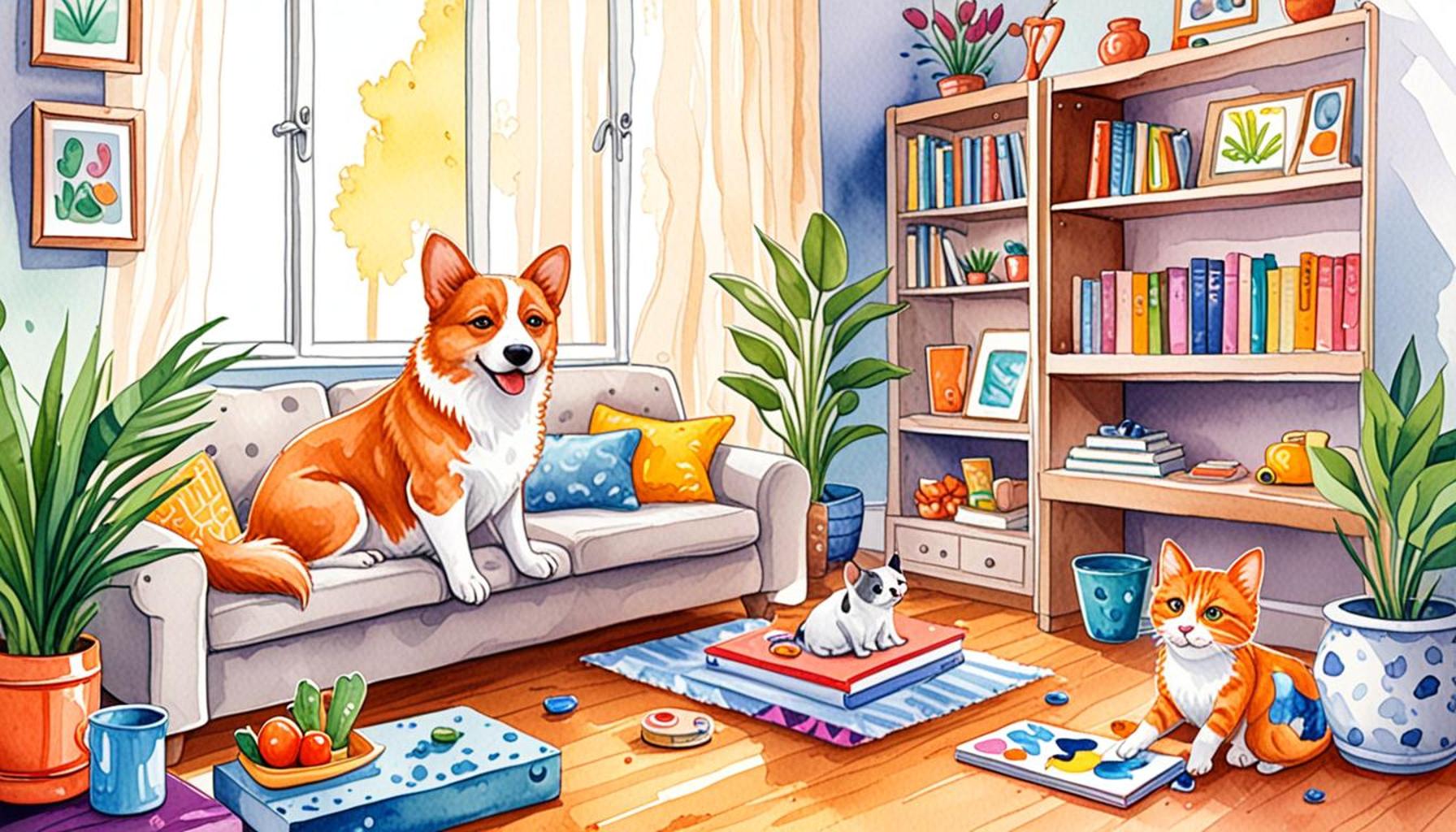Tips for Creating a Safe and Stimulating Environment for Pets at Home

Creating a Safe Space for Your Pets
Every pet owner dreams of a home where their furry friends can thrive. Creating a safe and stimulating environment not only enhances your pet’s well-being but also fosters a deeper bond between you and your animal companion. Follow these guidelines to transform your home into a haven for your pets.
Why a Safe Environment Matters
Pet safety in the home is essential for several reasons:
- Prevents accidents and injuries: A well-organized space minimizes the risk of household accidents, such as choking on small objects or slipping on slick floors. For instance, securing loose cables and removing choking hazards can significantly decrease injury risks.
- Reduces stress and anxiety in pets: An environment that feels safe and secure can help alleviate anxiety in pets, especially during thunderstorms or fireworks. Providing cozy spots with soft blankets or using calming plugins can make a wonderful difference.
- Encourages natural behaviors and play: Pets are naturally curious creatures; a safe space encourages them to engage in their instinctual behaviors, such as exploring, playing, and napping. Elements like climbing trees for cats or tunnels for small animals can enhance this experience.
A stimulating environment keeps pets mentally engaged and physically active, which is vital for their overall health. For example, interactive toys that dispense treats can keep dogs busy, while puzzle feeders can challenge a cat’s intellect.
Key Elements of a Pet-Friendly Home
When considering how to cultivate an enriching space for your furry friends, think about these important features:
- Secure hazardous areas, such as cleaning supplies: Many common household items, like cleaning solutions and medications, can be toxic to pets. Store these items in locked cabinets or high shelves to prevent accidental ingestion.
- Provide safe toys that stimulate their instincts: Choose toys that cater to your pet’s instincts, whether it’s a feather wand for cats or a squeaky toy for dogs. Rotating toys regularly can keep their interest piqued and encourage more play.
- Create designated play zones with plenty of space: Designating specific play areas lets your pets know where they can have fun. These zones should have ample room to run and explore while being free of harmful objects.
Moreover, fostering a variety of sensory experiences can benefit pets significantly, encouraging exploration and curiosity. Consider safe plants that cats and dogs can interact with, like catnip or safe herbs, which can stimulate their sense of smell.
By focusing on both safety and stimulation, you can ensure your home is a comforting sanctuary for your beloved pets. Explore the rest of this article for detailed tips and insightful suggestions to enhance your pet-friendly home. With careful planning and consideration, your home can become a vibrant space where your pets can live happily and healthily, enriching their lives and yours in the process.
LEARN MORE: Click here to unlock training success!
Designing Playful and Secure Spaces
Creating a harmonious coexistence between pets and their human companions starts with the layout of your home. A well-planned environment prioritizes both safety and stimulation, balancing your pet’s natural instincts with protection from potential hazards. When designing spaces for your pets, consider how each room can serve as an interactive playground that encourages exploration while ensuring safety.
Understanding Your Pet’s Needs
Each pet comes with its unique set of needs and preferences. Understanding these can significantly enhance the livability of your home for your furry friends. Here are a few tailored suggestions for different types of pets:
- Dogs: These affectionate creatures thrive with ample physical activity and mental stimulation. Designate a section of your yard or living room as a playful zone where dogs can run freely. Incorporate agility equipment such as tunnels and hurdles, and consider investing in durable chew toys and balls to promote active play.
- Cats: Independent yet playful, cats need opportunities to climb and explore. Install vertical shelves or cat trees that allow them to climb and perch high. Provide scratching posts and hidden hiding spots within boxes or under furniture for enrichment and mental stimulation.
- Small Animals: If you have rabbits or guinea pigs, a spacious habitat is essential. Offer tunnels, exercise wheels, and chew toys that cater to their instincts. Make sure their environment is clean, secure, and spacious enough to hop around comfortably.
Establishing Safe Boundaries
Establishing boundaries in your home is crucial for maintaining a safe environment. Ensure that areas such as kitchens and bathrooms are off-limits by using baby gates or pet barriers. It’s also essential to recognize that certain spaces may harbor hidden dangers for pets. For example:
- Examine the garden for toxic plants such as lilies, azaleas, or sago palms which can be harmful if ingested.
- Store fertilizer, pesticides, and other chemicals in secure locations that pets cannot access, ideally in locked storage cabinets.
- Be mindful of loose wires or cables, particularly for young pets who love to chew. Consider protective coverings to prevent electrocution risks.
By understanding your pet’s unique needs and implementing safe boundaries in your home, you can foster a space where they feel comfortable and secure. The goal is to create an engaging environment that offers enough enrichment to support their physical health and mental well-being. As you continue to explore various options, remember that integrating playful elements into your living space is just as important as safety, leading to a well-rounded sanctuary for your beloved companions.
Creating a safe and stimulating environment for pets at home goes beyond just ensuring physical safety; it involves enriching their surroundings to promote mental and emotional well-being. Keeping pets engaged with their environment has been shown to reduce anxiety and destructive behaviors. Here are some effective strategies to create such an environment:
Interactive Toys and Puzzles
Investing in interactive toys and puzzles can significantly elevate your pet’s daily experience. These gadgets require pets to think and solve problems, keeping their minds active. For instance, a food-dispensing puzzle can turn mealtime into a fun challenge, while toys that squeak or move can stimulate play.
Safe and Designated Spaces
Designate safe spaces in your home where pets can relax or engage in supervised play. Consider creating a cozy corner with their bed, toys, and a few blankets. This sanctuary allows pets to retreat, fostering a sense of security and comfort.
Regular Exercise
Physical activity is crucial for a pet’s health. Regular walks, playtime in the yard, or visits to the dog park can help channel their energy positively. Incorporating training sessions during these activities reinforces good behavior while establishing a bond between you and your pet.
Environmental Enrichment
Incorporating various textures and scents can enhance your pet’s interaction with their environment. Introducing elements like scratching posts for cats or tunnels for dogs adds excitement. Rotating toys and introducing new ones periodically prevent boredom, ensuring that your pets remain engaged.
Visual Stimulation
Positioning furniture strategically to create different levels for climbing or lounging can be visually stimulating for pets. For instance, cat trees or shelves designed for climbing can fulfil natural instincts and offer entertainment.
By integrating these elements, you create a home that not only safeguards pets but also contributes to their happiness and overall health. Adopting these tips can lead to a more harmonious living arrangement for both you and your beloved companions.
| Category | Description |
|---|---|
| Interactive Toys | Engages pets mentally, reduces anxiety. |
| Designated Spaces | Creates safe retreats for relaxation. |
| Regular Exercise | Encourages physical health and bonding. |
| Environmental Enrichment | Prevents boredom, satisfies instincts. |
| Visual Stimulation | Provides excitement and exploration. |
DIVE DEEPER: Click here for essential tips on pet nutrition
Incorporating Sensory Enrichment
To enhance your pets’ natural instincts and encourage mental engagement, incorporating sensory enrichment is essential. Just as we enjoy varied experiences, pets thrive when their environment offers different stimuli. From creating a vibrant atmosphere filled with stimulating sounds and scents to introducing new textures, the options are limitless. Here are a few effective ways to incorporate sensory enrichment:
Utilizing Sound and Texture
Sound can profoundly influence a pet’s experience at home. Consider playing nature sounds or calming music specifically designed for pets, which can create a relaxing backdrop. On the other hand, interactive toys that make noises can stimulate their curiosity. For texture, provide a range of surfaces for your pets to explore. You can place different materials such as soft blankets, sturdy rugs, or textured mats in their designated play areas. Cats, for instance, love to knead on soft fabrics, while dogs might enjoy rolling around on grass or gravel during outdoor playtime.
Engaging the Sense of Smell
The sense of smell is one of the most important for pets, especially dogs. Incorporate scent-based activities into your pet’s routine to tap into this instinct. Simple activities like hiding treats in cardboard boxes or using scent trails can keep both dogs and cats mentally stimulated. Additionally, you can create a “snuffle mat” for dogs by tying fabric strips onto a rubber mat, which encourages them to forage for hidden kibble, satisfying their natural digging instincts.
Interactive Spaces for Socialization
Pets are social creatures, and thus providing environments that foster social interactions is crucial. Designate areas where pets can safely interact with each other, either within your household or with visiting friends. For example, if you have multiple pets, consider creating “social zones” that allow them to coexist comfortably while minimizing conflicts. Using large, open spaces within your home can facilitate their play and reduce territorial issues. Moreover, establishing regular playdates or pet gatherings can also enrich their social experiences, contributing positively to their behavioral development.
Rotating Toys and Activities
Another effective strategy for maintaining an engaging environment is the regular rotation of toys and activities. Similar to how children can lose interest in the same toys, pets can experience boredom too. Rotate toys weekly or bi-weekly to keep your pets curious and engaged. Additionally, you can create themed play sessions, such as “obstacle courses” one day and “treat-hiding” exercises another, to challenge them in new ways and prevent monotony.
By investing in sensory enrichment, you can significantly enhance the quality of your pets’ lives, creating a home environment that promotes mental engagement and provides ample opportunities for exploration. Understanding their unique needs and interests will lead you to exciting ways to keep them happy, healthy, and, most importantly, entertained. As you prioritize sensory enrichment alongside safety, you will undoubtedly foster a stimulating sanctuary for your beloved companions.
LEARN MORE: Click here to discover the essentials of pet nutrition
Conclusion
Creating a safe and stimulating environment for your pets at home is not just about providing the basics; it’s about enhancing their overall well-being and quality of life. By combining elements of safety with a variety of sensory and social stimuli, you can ensure that your furry friends thrive in their living spaces. From implementing sensory enrichment techniques like sound, texture, and scent, to providing ample opportunities for social interactions, each aspect plays a vital role in your pet’s development and happiness.
Moreover, the importance of regularly rotating toys and activities cannot be overstated. This simple yet effective strategy keeps pets mentally agile and engaged, preventing boredom and destructive behavior. Remember, a vibrant home is one where your pets can explore, play, and interact comfortably. Every pet is unique, and understanding their individual preferences and instincts will help you tailor their environment to meet their specific needs.
Ultimately, by fostering a stimulating sanctuary at home, you not only promote your pets’ physical safety but also cater to their mental and emotional health. As you continue to learn and implement new strategies, remember that a happy pet is a reflection of your commitment to their well-being. Embrace these tips and transform your home into a thriving space where your pets can enjoy a fulfilling life, leading them to be healthier and more content companions.


